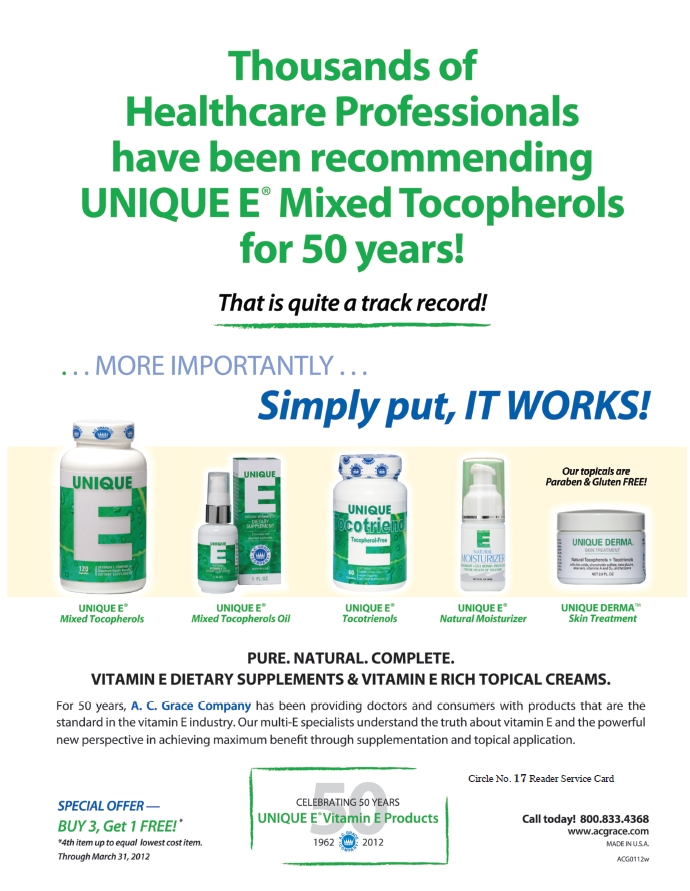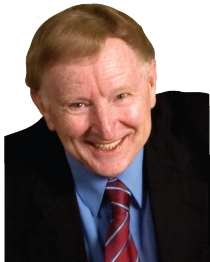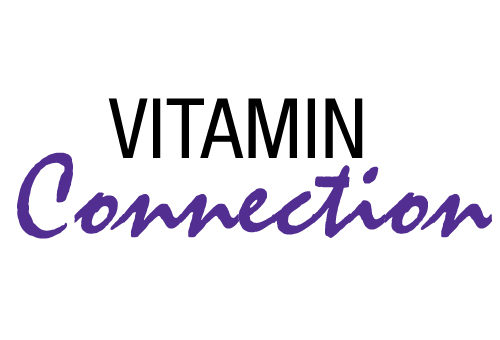Vitamin E is an essential nutrient. We can’t live without it. There are many published studies about the importance of vitamin E in health and disease prevention. Sometimes, however, a study is designed that doesn’t use the correct amount of vitamin E required to achieve the intended benefit or the study isn’t conducted long enough for vitamin E to bring about the biochemical changes needed. As an example, my epidemiological study of vitamin E and heart disease prevention indicated that it took two years for the preventive effect of vitamin E to be shown (1). This lag time was later verified by two studies conducted by Harvard scientists; one was of men and the other was of women (2, 3).
Sometimes, the studies are okay, and yet the attention-seeking media puts out an invalid conclusion. Last month, we discussed with Dr. Robert Smith how the media distorted a questionable observational study with multivitamins. Just as scientists were setting the record straight about that study, a vitamin E study captured headlines. Fortunately, Andrew W. Saul, Ph.D., quickly distributed accurate information through the Orthomolecular Medicine News Service (OMNS). Dr. Saul was kind enough to further discuss vitamin E and the recent report with us.
Many readers are familiar with Dr. Saul from his 10 books and his popular Web site, DoctorYourself.com. I particularly have enjoyed the four books he coauthored with Abram Hoffer, M.D. and his writings for the OMNS.
Dr. Saul has been an orthomolecular medical writer and lecturer for 35 years. Dr. Saul is also the editor of the Journal of the Orthomolecular Society and OMNS. He received the Outstanding Health Freedom Activist Award from Citizen’s for Health, and is the winner of three Empire State teacher fellowships.
Passwater: Dr. Saul, you have been researching the health benefits of vitamin E for decades. Thanks for your quick response to the recent vitamin E report.
Saul: The battle over vitamin E has been going full-tilt for over 60 years (4). The very first course I ever taught was called, “Forgotten Research in Medicine.” That was in 1976. The first Orthomolecular Medicine News Service release was on the clinical benefits of vitamin E. That was seven years ago (5). The news media and the medical profession seem to have very slow learning curves.
Passwater: How did you become interested in vitamins, natural healing and orthomolecular medicine?
Saul: It started in earnest when my first child was born. I was 22. They put the baby in my care and said, “Here, Dad.” Looking at that infant and then watching the hospital mishandle him for the next day or so convinced me that I had to do something. I started by taking my wife and son straight out of the hospital. It was a raging blizzard, and against the nurses’ and the doctors’ orders. They were making my child and my wife sick. I knew something was wrong, and I was instantly motivated to learn what I could do about it.
But you can’t just say no to medical care. You also have to say yes to an alternative. The alternative has to be at least as effective, and certainly had better be a lot safer. Nutritional medicine is more effective, and astronomically safer, than pharmaceutical medicine.
Passwater: What is most disturbing about the design flaws in the recent report (6) claiming that vitamin E may slightly increase the risk of prostate cancer?
Saul: That the media uncritically trumpet such nonsense (7). If you take a close look at the numbers, you will see that, “Compared with placebo, the absolute increase in risk of prostate cancer per 1,000 person-years was 1.6 for vitamin E, 0.8 for selenium, and 0.4 for the combination.” That works out to be a claimed 0.63% increase risk with vitamin E alone, 0.24% increase in risk with vitamin E and selenium, and 0.15% increase in risk for selenium alone.
Note the decimal points: these are very small figures. But more importantly, note that the combination of selenium with vitamin E resulted in a much smaller number of deaths. If vitamin E was really the problem, vitamin E with selenium would have been a worse problem. Selenium recharges vitamin E, recycling it and effectively rendering it more potent. Something is wrong here, and it isn’t the vitamin E. Indeed, a higher dose of vitamin E might work as well as E with selenium, and be more protective.
And, in fact, this study did show that supplementation was beneficial. Vitamin E and selenium reduced the risk of all-cause mortality by about 0.2%, and they also reduced the risk of serious cardiovascular events by 0.3%. Vitamin E alone reduced the risk of serious cardiovascular events by 0.7%. But just about all you were told was, “Vitamin E causes cancer!”
The oldest political trick in the book is to create doubt, then fear, and then conformity of action. The pharmaceutical industry knows this full well. One does not waste time and money attacking something that does not work. Vitamin E works, and the evidence is abundant.
Passwater: Aren’t there studies that show some forms of vitamin E destroy or halt the growth of prostate cancer in cell cultures? Hasn’t alpha-tocopherol shown some anti-cancer activity and both gamma-tocopherol and gamma-tocotrienol shown to be even more effective?
 Saul: Yes. Specifically in regards to prostate cancer, new research published in the International Journal of Cancer has shown that gamma-tocotrienol, a cofactor found in natural vitamin E preparations, actually kills prostate cancer stem cells (8). As you would expect, these are the very cells from which prostate cancer develops. Normally, they are or quickly become chemotherapy-resistant. And yet, natural vitamin E complex contains the very thing to kill them. Mice given gamma-tocotrienol orally had an astonishing 75% decrease in tumor formation. Gamma-tocotrienol also is effective against existing prostate tumors (9, 10).
Saul: Yes. Specifically in regards to prostate cancer, new research published in the International Journal of Cancer has shown that gamma-tocotrienol, a cofactor found in natural vitamin E preparations, actually kills prostate cancer stem cells (8). As you would expect, these are the very cells from which prostate cancer develops. Normally, they are or quickly become chemotherapy-resistant. And yet, natural vitamin E complex contains the very thing to kill them. Mice given gamma-tocotrienol orally had an astonishing 75% decrease in tumor formation. Gamma-tocotrienol also is effective against existing prostate tumors (9, 10).
Here is more evidence that vitamin E prevents and cures disease:
• Vitamin E reduced mortality by 24% in persons 71 or older in a 2011 study. Even persons who smoke live longer if they take vitamin E (11).
• Taking 300 IU vitamin E per day reduced lung cancer by 61% in another trial (12).
• Vitamin E is an effective treatment for atherosclerosis. Drs. Wilfrid and Evan Shute knew this half a century ago (5). In 1995, the Journal of the American Medical Association (JAMA) published research that confirmed it, saying: “Subjects with supplementary vitamin E intake of 100 IU per day or greater demonstrated less coronary artery lesion progression than did subjects with supplementary vitamin E intake less than 100 IU per day” (13).
• Another study found taking 400–800 IU of vitamin E daily reduced the risk of heart attack by 77% (14).
• Increasing vitamin E intake with supplements prevented chronic obstructive pulmonary disease, emphysema and chronic bronchitis (15).
• Other research found taking 800 IU vitamin E per day was a successful treatment for fatty liver disease (16).
• Alzheimer’s patients who took 2,000 IU of vitamin E per day lived longer in one trial (17).
• Taking 400 IU of vitamin E per day reduced epileptic seizures in children by more than 60% (18).
• Vitamin E supplements helped prevent amyotrophic lateral sclerosis. This important finding is the result of a more than 10-year Harvard study of over one million people (19).
• Vitamin E was more effective than a prescription drug in treating chronic liver disease (nonalcoholic steatohepatitis). Said the authors, “The good news is that this study showed that cheap and readily available vitamin E can help many of those with this condition” (20).
In other words, vitamins are clearly not the problem. Vitamins are the solution to the  problem.
problem.
Passwater: What kind of vitamin E? Which work best: natural or synthetic vitamins?
Saul: The general debate might not end anytime soon. With vitamin E, however, we already know. The best E is the most natural form, generally called, “mixed natural tocopherols and tocotrienols.” This is very different from the synthetic form, DL-alpha tocopherol. In choosing a vitamin E supplement, you should carefully read the label...the entire label. It is remarkable how many natural-looking brown bottles with natural-sounding brand names contain a synthetic vitamin. And no, I do not make brand recommendations. I have no financial connection with the health products industry.
Passwater: In the OMNS release, you also noted that the study authors had ties to the pharmaceutical industry.
Saul: You will not see this in the abstract at the JAMA Web site, of course, but if you read the entire paper, and get to the very last page (1,556), you’ll find the “Conflict of Interest” section. Here, you will discover that a number of the study authors have received money from pharmaceutical companies, including Merck, Pfizer, Sanofi-Aventis, AstraZeneca, Abbott, GlaxoSmithKline, Janssen, Amgen, Firmagon and Novartis. In terms of cash, these are some of the largest corporations on the planet.
Well, how about that: a “vitamins are dangerous” article, in one of the most popular medical journals, with lots of media hype…and the pharmaceutical industry’s fingerprints are all over it.
Passwater: Vitamin E is essential for life. How much vitamin E do we need for optimal health?
Saul: More than the recommended dietary allowance, and that’s for certain. A common dosage range for vitamin E is between 200 and 800 IU/day. Some orthomolecular physicians advocate substantially more than that. The studies cited previously will give you a ballpark idea. However, this is an individual matter for each person and his/her practitioner to work out. If the doctor quotes a negative vitamin study, then haul out the positive ones. Readers may start with this article. There are more links to more information at http://orthomolecular.org/resources/omns/v06n09.shtm and http://orthomolecular.org/resources/omns/v06n25.shtml.
Passwater: People still have safety concerns. What can we say about the safety of vitamin E and other essential vitamins?
Saul: As for the old saw argument that supplement users are supposedly dying like flies, consider this: Over 200 million Americans take vitamin supplements. So, where are the bodies? Well, there aren’t any. There has not been a single death from vitamins in 27 years (http://orthomolecular.org/resources/omns/v07n05.shtml). Share that with your doctor as well—and with the news media.
Passwater: Your especially informative Web site, www.doctoryourself.com, is non-commercial and also peer reviewed. How did it come about?
Saul: People have not been getting accurate information about nutritional therapies. For example, your doctor’s education may seem exhaustive, but it is not. Medical doctors are called medical doctors for a reason. They go to medical schools and they study medicine and then they prescribe medicines. Now, substitute the word “nutrition” in that sentence and see how impossible it sounds. Most medical personnel, and most medical Web sites, demonstrate that they are largely unfamiliar with high-dose nutrition therapy. They tend to dismiss it without knowing about what they’re dismissing. Vitamins and minerals are a superior, safer way to eliminate serious disease. Doctoryourself.com has worked for over 12 years to take this message, in detail, directly to the people. Free of charge, and without any advertising.
Passwater: What can we look for in the way of a new book?
Saul: Actually, The Vitamin Cure for Children’s Health Problems has just been published. It is coauthored with orthomolecular pediatrician Ralph Campbell, M.D. More are coming, including The Vitamin Cure for Infant and Toddler’s Health Issues.
Passwater: You were the co-author of four books with megavitamin pioneer, Abram Hoffer, M.D. That must have been a great experience. Dr. Hoffer was kind enough to endorse my book, Supernutrition, in 1975, in which I described my research along with the pioneering research of Dr. Hoffer and Dr. Linus Pauling. However, as difficult as this is to believe for long-timers in this field, there are many newcomers today who are not familiar with Dr. Hoffer. Where can they find his books today?
Saul: Many are still in print. Dr. Hoffer and I expanded and updated one of his major books and it was published in 2008 as Orthomolecular Medicine for Everyone. The Vitamin Cure for Alcoholism (2009) and Hospitals and Health (2010) are two more recent books that Dr. Hoffer co-wrote with me. Niacin: The Real Story has just been released. This is, in fact, Dr. Hoffer’s last work. It clears u p, once and for all, how safe and effective niacin therapy is, and exactly how to use it. It was indeed an honor to work with him on these projects.
p, once and for all, how safe and effective niacin therapy is, and exactly how to use it. It was indeed an honor to work with him on these projects.
Passwater: Dr. Saul, thanks for speaking with us and for your efforts to educate the media as well as individuals. The Orthomolecular Medicine News Service is a free educational newsfeed. How can readers subscribe?
Saul: To subscribe, free of charge, simply visit us online at www.orthomolecular.org/subscribe.html. WF
Dr. Richard Passwater is the author of more than 45 books and 500 articles on nutrition. Dr. Passwater has been WholeFoods Magazine’s science editor and author of this column since 1984. More information is available on his Web site, www.drpasswater.com.
References
1. R.A. Passwater, Prevention 28 (1) 63–71 (1976); Supernutrition For Healthy Hearts (Dial Press, New York, NY, 1977).
2. E.B. Rimm, et al., “Vitamin E Consumption and the Risk of Coronary Heart Disease in Men,” N. Engl. J. Med. 328 (20), 1450–1456 (1993).
3. M.J. Stampfer, et al., “Vitamin E Consumption and the Risk of Coronary Disease in Women,” N. Engl. J. Med. 328 (20), 1444–1449 (1993).
4. A.W. Saul, “Vitamin E: A Cure in Search of Recognition,” J. Orthomolecular Med. 18 (3, 4), 205–212 (2003) [free download at http://orthomolecular.org/library/jom/2003/pdf/2003-v18n0304-p205.pdf or html at www.doctoryourself.com/evitamin.htm]. See also: A.W. Saul, Review of The Vitamin E Story, by Evan Shute. J. Orthomolecular Med. 17 (3, Third Quarter), 179–181 (2002). www.doctoryourself.com/estory.htm.
5. “Vitamin E: Safe, Effective, and Heart-Healthy,” http://orthomolecular.org/resources/omns/v01n01.shtml
6. E.A. Klein et al., ”Vitamin E and the Risk of Prostate Cancer,” JAMA, 306 (14), 1549–1556 (2011), http://jama.ama-assn.org/content/306/14/1549.
7. S. Boyles, “Vitamin E Supplements May Raise Prostate Cancer Risk,” www.webmd.com/prostate-cancer/news/20111011/vitamin-e-supplements-may-raise-prostate-cancer-risk.
8. S.U. Luk et al., “Gamma-Tocotrienol as an Effective Agent in Targeting Prostate Cancer Stem Cell-Like Population,” Int. J. Canc.
128 (9), 2182–2191 (2011). http://onlinelibrary.wiley.com/doi/10.1002/ijc.25546/abstract
9. K. Nesaretnam et al., “Modulation of Cell Growth and Apoptosis Response in Human Prostate Cancer Cells Supplemented with Tocotrienols,” Eur. J. Lipid Sci. Technol. 110, 23–31 (2008). http://onlinelibrary.wiley.com/doi/10.1002/ejlt.200700068/abstract.
10. C. Conte et al., “Gamma-Tocotrienol Metabolism and Antiproliferative Effect in Prostate Cancer Cells,” Annals of the New York Academy of Sciences, 1031,391–394 (2004). www.ncbi.nlm.nih.gov/pubmed/15753178?dopt=AbstractPlus
11. H. Hemila and J. Kaprio, “Vitamin E May Affect the Life Expectancy of Men, Depending on Dietary Vitamin C Intake and Smoking,” Age Ageing, 2011. 40 (2), 215–220. http://ageing.oxfordjournals.org/content/40/2/215.short
12. S. Mahabir et al., “Dietary Alpha-, Beta-, Gamma- and Delta-Tocopherols in Lung Cancer Risk,” Int. J. Cancer 123 (5), 1173–1180 (2008). www.ncbi.nlm.nih.gov/pubmed/1854628Ser8; For further information: “Vitamin E prevents lung cancer,” Orthomolecular Medicine News Service, Oct 29, 2008. http://orthomolecular.org/resources/omns/v04n18.shtml
13. H.N. Hodis et al., “Serial Coronary Angiographic Evidence that Antioxidant Vitamin Intake Reduces Progression Of Coronary Artery Atherosclerosis,” JAMA, 273, 849–1854 (1995). http://jama.ama-assn.org/content/273/23/1849.short
14. N.G. Stephens et al., “Randomized Controlled Trial of Vitamin E in Patients With Coronary Artery Disease: Cambridge Heart Antioxidant Study (CHAOS),” Lancet 347:781–786 (March 23, 1996). www.ncbi.nlm.nih.gov/pubmed/8622332
15. A.H. Agler et al., “Randomized Vitamin E Supplementation and Risk of Chronic Lung Disease (CLD) in The Women's Health Study,” American Thoracic Society 2010 International Conference, May 18, 2010. Summary at www.thoracic.org/newsroom/press-releases/conference/articles/2010/vitamine-e.pdf
16. A.J. Sanyal et al., “Pioglitazone, Vitamin E, or Placebo for Nonalcoholic Steatohepatitis,” N. Engl. J. Med. 362 (18), 1675–1685 (2010). www.ncbi.nlm.nih.gov/pubmed/20427778
17. V.N. Pavlik et al., “Vitamin E Use Is Associated with Improved Survival in an Alzheimer's Disease Cohort,” Dement. Geriatr. Cogn. Disord. 28 (6), 536–540 (2009). Summary at www.associatedcontent.com/article/719537/alzheimers_patients_who_take_vitamin.html?cat=5. See also: M. Grundma, “Vitamin E and Alzheimer Disease: The Basis for Additional Clinical Trials,” Am. J. Clin. Nutr. 71 (2), 630S-636S (2000). Free full text at www.ajcn.org/cgi/content/full/71/2/630s.
18. A.O. Ogunmekan and P.A. Hwang, “A Randomized, Double-Blind, Placebo-Controlled, Clinical Trial of D-Alpha-Tocopheryl Acetate [Vitamin E], as Add-On Therapy, for Epilepsy In Children,” Epilepsia. 30 (1), 84–89 (1989). www.ncbi.nlm.nih.gov/pubmed/2643513
19. H. Wang et al., “Vitamin E Intake and Risk of Amyotrophic Lateral Sclerosis: A Pooled Analysis of Data From 5 Prospective Cohort Studies,” Am. J. Epidemiol. 173 (6): 595–602 (2011). http://aje.oxfordjournals.org
/content/173/6/595.short 20. A.J, Sanyal et al., “Pioglitazone, Vitamin E, or Placebo For Nonalcoholic Steatohepatitis,” N. Engl. J. Med. 362 (18), 1675–1685 (2010). www.nejm.org/doi/full/10.1056/NEJMoa0907929
Also of Interest:
“Vitamin E Research Ignored by Major News Media,” Orthomolecular Medicine News Service, May 25, 2010, http://orthomolecular.org/resources/omns/v06n19.shtml
Published in WholeFoods Magazine, January 2012










